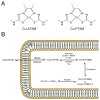Underscoring the influence of inorganic chemistry on nuclear imaging with radiometals
- PMID: 24313747
- PMCID: PMC4151561
- DOI: 10.1021/ic401607z
Underscoring the influence of inorganic chemistry on nuclear imaging with radiometals
Abstract
Over the past several decades, radionuclides have matured from largely esoteric and experimental technologies to indispensible components of medical diagnostics. Driving this transition, in part, have been mutually necessary advances in biomedical engineering, nuclear medicine, and cancer biology. Somewhat unsung has been the seminal role of inorganic chemistry in fostering the development of new radiotracers. In this regard, the purpose of this Forum Article is to more visibly highlight the significant contributions of inorganic chemistry to nuclear imaging by detailing the development of five metal-based imaging agents: (64)Cu-ATSM, (68)Ga-DOTATOC, (89)Zr-transferrin, (99m)Tc-sestamibi, and (99m)Tc-colloids. In a concluding section, several unmet needs both in and out of the laboratory will be discussed to stimulate conversation between inorganic chemists and the imaging community.
Conflict of interest statement
The authors declare no competing financial interest.
Figures










References
-
- Strauss HW, Mariani G, Volterrani D, Larson SM. Nuclear Oncology: Pathophysiology and Clinical Applications. Springer; New York: 2012.
-
- Heller GV, Hendel RC. Handbook of Nuclear Cardiology: Cardiac SPECT and Cardiac PET. Springer; New York: 2012.
-
- Wadas TJ, Wong EH, Weisman GR, Anderson CJ. Curr Pharm Des. 2007;13:3–16. - PubMed
MeSH terms
Substances
Grants and funding
LinkOut - more resources
Full Text Sources
Other Literature Sources
Miscellaneous

